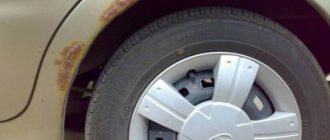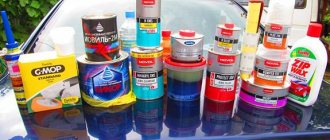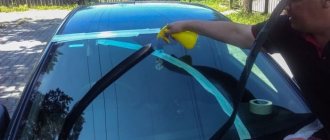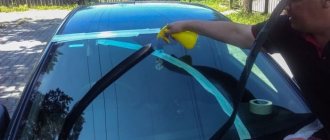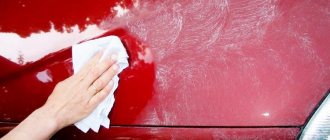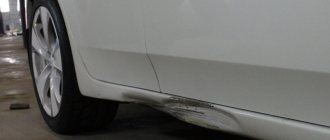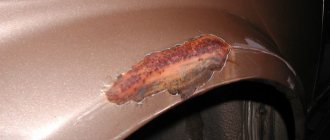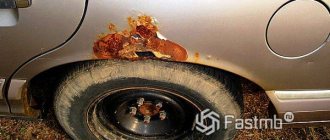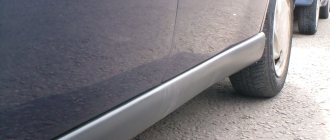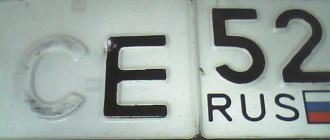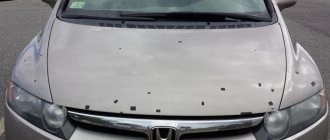Many car enthusiasts are familiar with the problem of rust on cars. Drivers are especially concerned about the appearance of corrosion on the galvanized surface of the bottom, since it is known that the zinc layer should prevent these destructive processes from developing. In reality, it is designed to slow down the appearance of rust on the surface of the car and is not able to resist its appearance, especially in salty winter conditions.
Causes of corrosion
The occurrence of rust in the bottom leads to the formation of holes, which causes a decrease in the strength of the entire body structure. This may lead to an emergency situation. Therefore, it is important to know effective methods to help eliminate existing corrosion.
Every time the bottom of a car interacts with bumps on the road or crushed stone that flies out from under the wheels while driving, the integrity of the protective coating is compromised. This leads to the appearance of cracks in the mastic layer. This is where water and dirt will collect - they are obligatory companions of a rusty body. That is why it is important to carry out high-quality anti-corrosion protection of the underbody of the car.
Types of corrosion
There are several types of rust on the surface of a car, depending on which different methods of anti-corrosion treatment are used. According to the conditions of occurrence, the following types of rust can be distinguished:
- gas - appears on the mufflers or exhaust pipe;
- in electrolytes – located in places where moisture stagnates;
- contact rust - appears in areas where metals of different potentials come into contact;
- under friction conditions – observed in places where there is a corrosive environment;
- crevice - in cracks or gaps where water accumulates in contact with oxygen;
- biocorrosion – associated with the influence of microorganisms and their metabolic products;
- mechanical - occurs from impacts of crushed stone flying from under the wheels, tall grass, bumps on the road, which rip off the protective layer from the bottom of the car.
Recommendations for selection
Anticorrosive is classified depending on:
First, you need to remember that anticorrosive agents can be divided into products for internal and external surfaces. It is not recommended to use internal anti-corrosion compounds to treat the underbody of a car. They will not be able to demonstrate the same effectiveness as products specifically designed for the most frequently exposed surfaces. The car owner should decide on the appropriate type of mastic, understand the requirements, and then purchase the most effective composition. There are some good tips on this matter.
There are products that are used for their intended purpose when treating hidden and hard-to-reach surfaces. They are not used for the bottom due to low efficiency and structural features of the substance. Such anti-rust preparations are made on the basis of oils or paraffins. Oily products are characterized by a liquid structure that does not change even after drying. Copes well with microcracks and scratches. And paraffin ones are made from wax. When the drug dries, an elastic film remains. High-quality mixtures do not lose their effectiveness even under conditions of sudden temperature changes. If you need to treat the bottom of the vehicle, the following types of anticorrosives are used:
The question quite naturally arises as to which anticorrosive agent for cars is the best to effectively resist rust and corrosion.
The answer is not so easy to find, since anti-corrosion agents can indeed differ significantly from each other. But practice clearly shows that when treating the bottom it is better to use bitumen, rubber or PVC compounds. Do not forget about the high importance of quality, since not all manufacturers use the components stated on the packaging. There is no point in saving money here, since a really good anti-corrosion agent cannot be cheap.
Requirements
We are getting closer and closer to which anticorrosive agent is best to choose for your car. For a fairly old vehicle, the condition of the factory protection leaves much to be desired. When choosing an anti-corrosion composition, you need to focus on the maximum effectiveness of the protective layer it creates. In order for the product to work efficiently and prevent rust from spreading further along the bottom of the car, certain requirements must be presented. Namely:
If the anticorrosive agent does not meet at least one of the requirements, it is better not to use it. Still, the effect will not last long. When you buy a new car and plan to sell it in a few years, there is no need to buy expensive anticorrosion agents. Factory protection is enough to withstand even fairly aggressive operating conditions during this period.
But if the car is no longer new, and the conditions on the road are far from perfect, anticorrosive protection will definitely not hurt you. Buy only high-quality mixtures designed specifically for the underbody of the car. And do not forget to strictly follow the application requirements prescribed by the manufacturer. Some formulations have a special technology of application. Therefore, the desired effect can only be achieved through a detailed study of the original instructions.
Properties and capabilities of different compositions
To choose the best anticorrosive agent for your car, you need to understand in more detail the features of different materials, their properties and real capabilities. Not all compounds can be equally effective in treating the underbody of a car. If you want the treated surface to have maximum protection, think carefully about which anticorrosive agent would be best to use in your particular case. After all, a car can be treated with different compounds. Mastics have gained the most popularity among motorists. But keep in mind that the composition of the mastic varies depending on the components used. There are several categories of mastics:
But the choice doesn’t end with mastics. There are several other categories of products that are classified separately from mastics:
Frequency of anti-corrosion treatment
Checking for rust and the condition of the anti-corrosion coating should be done regardless of whether the car is new or used. Because it happens that even a new car will need to apply additional anti-corrosion protection. If repairs were made or the car was damaged in an accident, the anti-corrosion protection will need to be restored.
Experts believe that inspection should be done once a year. After complete anti-corrosion treatment, the car will be protected for 4-5 years.
Properties of anti-corrosion coating
Any anti-corrosion coating must have the following important qualities:
- abrasion resistance – the ability to protect car parts from regular exposure to abrasives;
- environmental friendliness - rust removal products must be environmentally friendly;
- frost resistance - the product must retain all its properties even at low temperatures;
- high activity - the drug must be well saturated to stop corrosion;
- plasticity - since constant vibrations and deformations are possible during movement;
- the material must be retained on the surface of the car at high temperatures.
Preparing tools
If you remove rust from the bottom of a car with your own hands, then to carry out the work you need to purchase special materials and prepare tools:
- sanding machine or sandpaper;
- putty knife;
- blowtorch;
- mastic remover;
- metal brush or roller;
- degreaser;
- anti-corrosion primer;
- rust converter;
- putty;
- latex gloves;
- paper mounting tape.
How to treat the underbody of a car against corrosion with your own hands?
Of course, treating the underbody of the car is the responsibility of the manufacturer. As a matter of fact, this is exactly the situation in all factories where the bottom is covered with various mastics and other similar protective compounds. But, it may well be that the car you bought was not treated properly, and if it was done at the right level, then all the same - time necessarily reduces the strength of protection against corrosion of any coating. So, in the future you will have to protect the bottom of the car on your own, that is, treat it again. If you want to process it with your own hands, then in this case you cannot do without certain knowledge.
Carrying out rust removal work
Anti-corrosion cleaning of the underbody of the car should be carried out only after washing, since this way you can see all the problem areas. After drying the body, you should begin examining the surface to identify pockets of rust or swollen paint.
The next stage of work is to clean the affected area. Cleaning time directly depends on the method used to remove the old layer of mastic. So, the most time-consuming and tedious method is cleaning with a wire brush or sandpaper. Using a grinding machine, you can prepare the surface for further work much faster.
Important: you need to clean the area 3-4 cm around the rust stain until a smooth and even surface appears.
After the cleaning work is completed, you need to treat the problem area with a degreasing solution and apply a rust converter. Its main task is to transform the rust remaining on the bottom into soil. It is applied using a regular rag. After waiting for the corrosion converter to dry, you can apply a new layer of anti-corrosion coating.
Anti-corrosion treatment of the underbody of the car. What is the best way to process it and how to do it?
Corrosion of the bottom is the effect of rust on it, and it appears, as you know, from excess moisture. The same trips through puddles, fog and rain do not pass without leaving a trace. All this precipitation affects the car, especially if there is any damage to its underbody. And such damage is unlikely to be avoided for a long time. After all, when driving, small stones always fly. Tall grass and sandy roads also have a great impact on the protective layer underneath the car body. In winter, the defense also does not rest. Now it is negatively affected by ice growths, which damage the overall integrity of the entire protective layer.
The result of exposure to rust is the gradual formation of holes in the car body, which clearly does not add strength to it. At the same time, deformation of various bends on it is quite possible. So, here you need to urgently stop corrosion and somehow protect the health of the entire body of your car as a whole.
What to process?
You can do this using mastic. It preserves the metal and can also protect it from damage. Its basis is the well-known bitumen; in addition to it, the mastic also contains rubber and various types of resins.
There are materials where the base is PVC (this letter combination means polyvinyl chloride) and the same rubber. This coating can be described as quite durable, which is why it is often used in factories.
The next material is liquid plastic. It should not be used as the main means of protecting the bottom, because mechanical damage, even not too strong, can easily damage it.
Oil-based compounds do not dry out completely during the entire operation of the car, and when fresh cracks appear, their liquid state helps to quickly fill these cracks.
Compositions based on paraffin and wax. After application, such a protective layer dries, and thus an elastic film is obtained, which serves as protection for the bottom of the car.
Bottom treatment. 3 main ways
So, the bottom can be processed in different ways. Choose the method that is right for you, choose the material, and start “treating” the lower part of the body of your car.
Passive method
First of all, the bottom will need to be washed well, then dried well, and rust should be removed from it, and along with it the remnants of old mastic. Next, the bottom is primed, after which it is covered with mastic. It is very important to dry the bottom thoroughly so that any remaining moisture does not begin to destroy the coating itself again, and with it the bottom itself.
Active method
Here you need to act in the same way, but the mastic needs to be replaced with an active substance (like Movil). It will protect the bottom from corrosive processes, and plus it will prevent rust from “taking root” on it in the future. If you decide to use such a product, you won’t even have to remove the old mastic. There is no need to do this; both of these products will interact perfectly, which will strengthen the overall protective coating of the lower part of the body.
Transformative method
It is used when there are traces of corrosion processes on the bottom. Here they use a special product, which, when applied to damaged surfaces, converts rust into a mass that serves as a protective primer. Next, use any of the previous processing methods.
How to process it yourself?
This is quite possible to do if you know the general sequence of actions and choose the protective material wisely. So let's begin:
- First, we drive the car onto a lift, or in some other way we provide good access to the entire area of the bottom of the car.
- We remove all the rust and the remnants of the old protection, after which the bottom of the body is thoroughly cleaned with a metal brush.
- Now you need to wash it well and be sure to dry it completely so that no moisture remains on the bottom. Otherwise, the new coating will not be able to fully perform its functions for a long time.
- Apply a protective agent to the dry bottom. More than one layer can be applied, it all depends on the type of product itself.
- We are waiting for the product to reach its working condition, that is, to harden to the required degree. You can find out on the packaging when this happens. Usually this is a day.
It seems that there are no difficulties when processing the body, but this work is, of course, painstaking, where it is necessary to show a certain diligence. So, it’s up to you to decide whether to do it yourself or give the car to specialists.
What protective mastics should be used to treat the underbody of a car, and how we are deceived in car services, you will learn from this video. Let's see.
Did you like the article? Subscribe to the channel to stay up to date with the most interesting materials
Car protection inside the cabin
Cleaning the underbody of the car from corrosion should take place not only outside, but also inside the cabin. The corrosion process is accelerated by snow that sticks to the soles of boots or the radiator of the heating system.
Therefore, the bottom inside the cabin also needs to be coated with a thin layer of mastic, after having previously dismantled the chairs, carpets and other interior elements.
Most modern cars have a galvanized body. But this is only partial protection against rust, so an additional anti-corrosion coating should be applied.
The appearance of rust on a car body is an unpleasant occurrence for every car owner. In this article we will tell you how to quickly and easily remove rust stains from a car body using available means. All methods are simple and effective, you can easily do them yourself.
Mastics for treating body underbody
To protect the car body, three main types of mastic are used:
- rubber bitumen;
- polymer-bitumen;
- epoxy.
Any mastic is characterized by a fairly low cost, is characterized by ease of use and high durability. Products under the Bikar and Allright trademarks are known on the Russian market; anti-corrosion material is applied with a brush or spray gun and has good adhesion.
It is better to dilute the bitumen-rubber mastic “Oilwright” with regular gasoline and apply it in warm or hot weather. Mastic on the bottom of the car holds better than anti-gravel sprayed from a can, does not crack and resists mechanical stress well. As a rule, treatment with this product is enough for 2-3 years of car operation, but the big disadvantage is that bitumen mastic stains everything possible, and it smells quite unpleasant.
Corrosion formation
Metal corrosion , or simply rust, appears as a result of metal oxidation under the influence of the environment. The main reason for its appearance is damage to the paint on the car body.
All resulting scratches and chips sooner or later become a source of rust formation, which gradually spreads deeper into the stain and over the entire larger surface area of the body.
The rate at which corrosion spreads depends on the aggressiveness of the environment and the condition of the body itself. For example, in the winter season it spreads many times faster.
It is much easier to deal with a single rust stain that has just appeared than with multiple “saffron caps” or an old stain where the metal is corroded almost completely.
All about treating the underbody of a car against corrosion with your own hands
Main types of corrosion
There are different degrees of corrosion, in terminology they are called:
Requirements for materials for anti-corrosion treatment
Anticorrosives for the bottom are divided into two types. The first type is necessary to cover the outer surface of the bottom of the car, which is constantly exposed to the mechanical action of sand, gravel, and stones. Anti-gravel mastics made on the basis of polymer, bitumen and rubber, which have the property of elasticity, are applied to defective areas.
To use these mastics you need a sprayer or a brush to cover them with a thick layer. For the quality of spraying treatment, a good device is required because this type of mastic is sold in a jelly-like consistency.
The second type is necessary to cover hidden cavities in the bottom of the car. Oil or wax based mastics are applied to these problem areas. They may contain rust inhibitors. This type of product has the property of penetrating into gaps, cracks, tears and chips.
Due to the fact that their consistency is not as thick as that of anti-gravel compounds, they have useful water-repellent and moisture-displacing qualities, as well as the ability to neutralize corrosion by impregnating the site of occurrence.
Noteworthy anticorrosive brands
To reliably treat the bottom of your vehicle from emerging pockets of rust, you need a high-quality anti-corrosive agent. Below we list the main brands from well-known manufacturers.
Manufactured on a wax basis
The most popular are the following:
Manufactured from rubber, polymer and bitumen
Movili for the bottom
To prevent the occurrence of rust on the car body, before covering it with high-quality paint, it is recommended to apply Movil. Most car owners call any type of anticorrosive agent Movil, but this is absolutely false. Movil contains elements that prevent corrosion, these are:
To determine which Movil is needed, you should find out the type of corrosion. They exist in three subspecies:
When Movil is purchased, you need to carefully prepare problem areas outside and inside the underbody, which you will have to clean, seal and coat with anti-corrosive.
Stages of the mastic processing process
The process of treating a vehicle body against corrosion has several stages:
Anticorrosive recipes
In order to save money and get a better quality product, you can prepare the product yourself.
Recipe No. 1
All components are mixed, after which the underbody anticorrosive is ready. Next, it is heated and applied to the damaged areas in 2 stages.
Recipe No. 2
All components are added one piece at a time. The result is a composition that becomes like wax in the cold, and like a flowing liquid in the heat.
Recipe No. 3
To prepare it, take in equal parts:
What is the bottom treated with at the VAZ plant?
The first protective barrier against metal corrosion in VAZ production is applied galvanic coating, better known as zinc. It is often used in any automobile plant. All vehicle production plants apply different thicknesses of zinc coating to areas where welding was used.
Galvanized steel, even if the protective barrier is destroyed, does not corrode for a certain period. After the zinc coating, industrial primer and a second layer of elastic and moisture-resistant mixture are applied, which has shockproof properties and also reduces noise inside the cabin.
Corrosion Removal Methods
Corrosion can be eliminated in the following ways:
- Mechanical – used for severe corrosion, it involves removing rust by stripping down to metal, followed by priming, puttying and painting the area of the body being repaired;
Advantages of the method: elimination of large and deep stains, damage under swelling paint, as well as low cost and availability of the necessary materials.
Disadvantages: length of the process.
- Chemical - involves using rust removers. Such reagents are widely represented on the modern market.
Advantages of the method: elimination of corrosion in hard-to-reach places, higher process speed.
Disadvantages: inability to use on heavily damaged areas.
Let's consider the process of eliminating corrosion using each of the methods presented above in more detail.
Step-by-step instruction
Before starting repair work, it is necessary to inspect the body and identify all problem areas. Assess the degree of damage and decide on a method to eliminate corrosion.
Tools and materials
Before starting work you need to prepare:
- grinder;
- sandpaper;
- degreaser;
- putty;
- primer;
- paint;
- car varnish;
- rust converter;
- masking tape;
- clean cloth.
Mechanical method
Removing rust stains mechanically is carried out in several stages:
- cleaning corrosion down to metal with sandpaper. The work can be done manually or using a power tool, such as a grinder. The stain should be cleaned gradually and carefully, avoiding rough scratches. It is important not to damage entire areas of the paintwork and to carry out 100% complete stripping down to “bare” metal.
- treating the prepared area of the body with a rust converter in order to eliminate the smallest corrosion residues that are not always visible to the eye.
- degreasing the surface after the converter ends (on average after half an hour);
- putty (carried out in several layers if necessary) and grinding of the treated surface;
- painting in body color (before painting, protect adjacent parts of the body with newspapers and masking tape and apply an anti-corrosion primer in 2-3 layers). Painting is also carried out in 2-3 layers, each thoroughly drying.
- application of clear varnish (if desired) for more reliable protection and a beautiful appearance.
The result of the work will depend entirely on compliance with all instructions and the correct execution of the work. If the technology is violated, for example, due to poor-quality cleaning or insufficient drying, the result of the work may be completely short-lived.
Watch a video on how to remove rust from a car in 10 minutes:
Chemical method
The significant difference between this method and the previous one lies only in the first stage - cleaning from rusty stains. Instead of mechanical cleaning, specialized chemicals are used. It can remove rust and prevent its further spread without damaging the metal.
As a rule, such preparations are applied to the problem area in accordance with the manufacturer's instructions for the specified time, after which the remaining product is wiped off or washed off.
